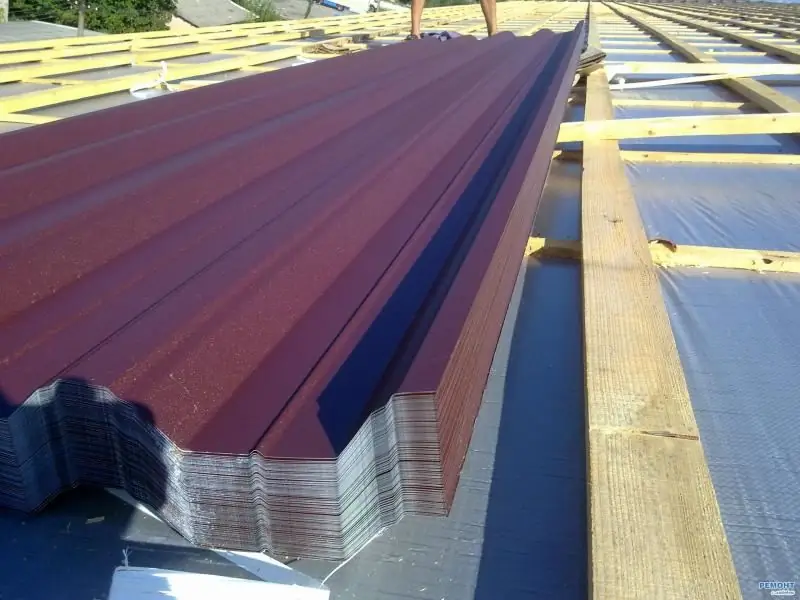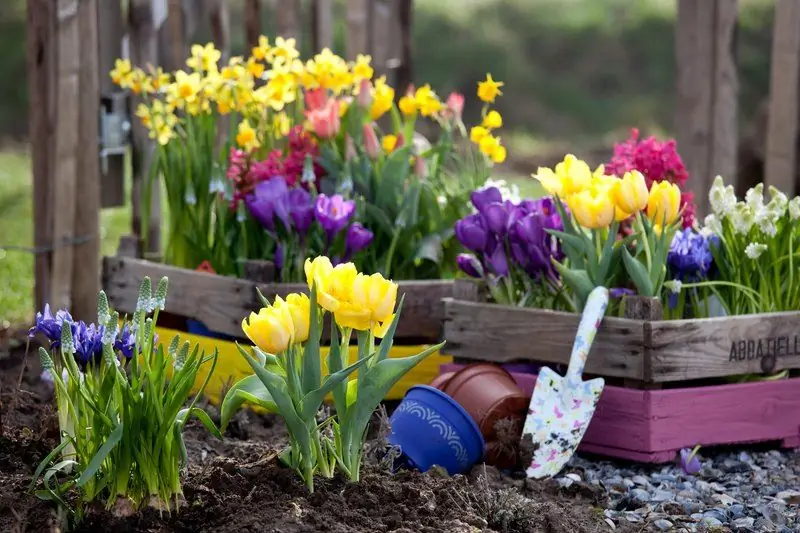
Table of contents:
- Author Bailey Albertson [email protected].
- Public 2023-12-17 12:53.
- Last modified 2025-01-23 12:41.
Once processing, two and three - spheroteka, leave the gooseberry

By purchasing a plot of land for a summer cottage and planting gooseberries on it, you hope for a harvest of bright, fragrant fruits filled with vitamins. Imagine disappointment when, instead of glossy berries and malachite greens, you find folded withered leaves and nondescript fruits covered with a whitish-gray dense bloom. Meet: spheroteka - the causative agent of powdery mildew. As soon as she takes a fancy to gooseberry bushes, she has to forget about a good harvest.
Content
- 1 How powdery mildew appears
-
2 How to deal with powdery mildew
-
2.1 Prevention of gooseberry lesion by spheroteka
2.1.1 Video: treatment of currant and gooseberry bushes with boiling water against powdery mildew
-
2.2 Gooseberry treatment
- 2.2.1 Terms and conditions of treatments
- 2.2.2 Preparations and folk remedies for the treatment of gooseberries from powdery mildew
- 2.2.3 Video: how to treat gooseberries from powdery mildew
-
How powdery mildew appears
Spheroteka is the scourge of old gooseberry plantings. It is a microscopic powdery mildew that parasitizes the shoots, leaves and fruits of plants. In the spring, a whitish coating appears on them, which then becomes darker. First, young leaves and twigs located closest to the ground are affected (there is less light and higher humidity), then the whole plant is involved. The leaves curl, the affected shoots are deformed and wither, the ovary and berries crumble. The remaining fruits lose their attractive appearance and taste.
Spheoteca often appears as a result of a violation of agricultural technology, when young bushes are planted next to one or two-year-old fruit trees, not considering that over time they will grow and the bushes will be thickened or shaded. And the hand does not rise to destroy adult plants …

Gooseberries affected by spheroteka are not suitable for human consumption.
How to deal with powdery mildew
Since the spheroteca affects the whole plant, the “point” removal of diseased leaves or fruits does not give an effect. We process the entire bush, and do not spray it, but pour it abundantly from top to bottom, grabbing the lower part of the leaf blade. Since the spores of the fungus hibernate in the soil, we also irrigate the ground under the bushes. We apply treatments to currants and yoshta, if they grow nearby. As a result, we get rid of pathogens and maintain plant immunity, preventing the spread of parasites that prefer bushes weakened by the fungus.

Plants weakened by spheroteka are more likely to be occupied by parasites
There are two directions of the fight against spheroteca: prevention and treatment.
Prevention of gooseberry lesion by spheroteka
It is easier to prevent powdery mildew than to treat bushes already affected by the fungus.
Prevention includes:
- selection of resistant varieties;
-
observance of agricultural techniques:
- provision of illumination and ventilation of the bushes;
- timely pruning and formation of plants;
- destruction of deformed shoots;
- burning of fallen fruits and diseased leaves;
-
removing weeds and loosening the soil around the plants;

Gooseberry bushes with loose soil around Removing weeds and loosening the soil around the gooseberry bushes is the prevention of powdery mildew and other diseases.
- the introduction of potash and phosphorus fertilizers. Since young leaves and shoots are especially sensitive to powdery mildew, it is necessary to completely abandon nitrogen fertilizers that stimulate their formation;
-
treatment with drugs:
- biopreparations Fitosporin-M and Alirin-B (contain hay bacillus extract - a natural antagonist of fungi, non-toxic), Pentafagom-C (includes five active bacterial components);
- means of chemical protection with antifungal action: 1% solution of copper sulfate, Bordeaux liquid and other copper-containing preparations;
-
Immunocytophyte (exhibits an immunostimulating effect, reduces stress from adverse natural factors, has the ability to prevent fungal infections);

Immunocytophyte Immunocytophyte - plant growth regulator and stress-generating agent
- early spring dousing with boiling water (when the snow has not yet melted, but there is no threat of severe frosts, and the kidneys should not be awakened). Watering from a watering can, abundantly irrigating the bushes.
Video: treatment of currant and gooseberry bushes with boiling water against powdery mildew
Gooseberry treatment
The second direction is the treatment of already diseased plants. For this purpose, spraying with fungicidal preparations is used if the lesion is extensive, and folk methods, if the spheroteka has just appeared on the bushes.
Terms and conditions of processing
They begin to process the bushes with the appearance of young foliage, then repeat the processing after flowering and after picking berries, but before leaf fall. Depending on the region, the first treatment is carried out from mid-May to early June.
The bushes are sprayed in the evening in dry, calm weather, so that the plants do not get burned, and the remedy reaches its goal: it is not washed off by the rain or dispersed by the wind. When using toxic drugs, personal protective measures are used for safety: goggles, respirators, gloves. All chemicals are diluted strictly in accordance with the instructions for use, they do not use expired and unsigned reagents.

Spraying gooseberries must be carried out with gloves and a respirator
When we bought the plot, it already had a gooseberry - two huge bushes with small dark purple oblong berries. I had to dig up one of them, as the eerie crooked thorns made it impossible to collect the fragrant fruits. And a low, spreading bush with almost smooth shoots gave large amber berries, the seeds of which were shining in the sun - it is a pleasure to collect. It was only after a year or two that I realized that small berries from a thorny bush are always clean, although they grow on the northern side of the site. And the thornless gooseberry, located to the south, is affected by powdery mildew. The neighbor built the house too close to the fence, and the plant was in the shade. I considered it unpromising to waste time and energy fighting the fungus, so I had to dig out a bush with a large clod of earth and replant it. In the new place, there are no nearby fruit trees, only a patch of garlic and spicy herbs. Such a neighborhood is ideal for scaring off pests, and I don't like chemistry, so I spray the bush with exclusively sour milk or a fresh light pink solution of potassium permanganate. So far I haven't noticed any traces of the spherotek.
Preparations and folk remedies for the treatment of gooseberries from powdery mildew
The most common chemicals are:
- HOM - contains copper, is used for the prevention and treatment of plants from powdery mildew;
- Topaz is a fast acting systemic fungicide. The active substance penconazole can accumulate in the soil, therefore it is undesirable to use it for more than three years in one place;
-
Tiovit Jet is a sulfur-containing fungicide.

Tiovit-Jet 1 kg of Tiovit Jet contains 800 g of high quality sulfur
All of these drugs are moderately hazardous to humans (third class), and Nitrafen, which is still offered as a broad-spectrum agent, is very toxic.
Folk remedies:
- ash infusion (1 glass of ash + 2 liters of boiling water, leave for 5-6 days, then strain and spray the bushes);
- soda solution (2 teaspoons per 5 liters of water, dissolve and spray immediately);
-
infusion of onion husks (1 liter of dry husk per 5 liters of boiling water, leave for 2-3 days, then strain and spray the bushes);

Infusion of onion peel Infusion of onion peel is insisted for 2-3 days
- fresh slightly pink solution of potassium permanganate.
To improve the adhesion of solutions, grated laundry soap is added to their composition.
Video: how to treat gooseberries from powdery mildew
To enjoy the view of healthy bushes in summer, strewn with emerald, amber or ruby gooseberries, and to drink tea with luxurious jam on chilly winter evenings, you should think about the health of the bushes in advance. They need nurturing care, consistent prevention and treatment.
Recommended:
How To Clean And Cut Fish Correctly: Methods Of Fillet Processing, What To Do To Prevent Scales From Flying, How To Gut And Other Recommendations + Video

How to clean fish properly. How can you cut it. Processing methods for different varieties. Step by step instructions. Photo and video
Which Epilator Is Better For Home Use - Laser And Other Types, For The Face And Bikini Area, Options For Sensitive Skin, Basic Parameters And User Reviews

Appointment and types of epilators. Description of the action of the devices. How to choose the best among them. What are the rules for caring for him. Reviews of the best brands
Roofing Profiled Sheet, Including Its Types With Description, Characteristics And Reviews, As Well As Processing And Use Features

Using a profiled sheet to cover the roof. Classification, features of work and operation of corrugated board. How to cut a profiled sheet into fragments of the desired size
Planting Tulips In Spring: When And How To Plant Correctly In Open Ground And Pots

How to properly plant tulips in spring in soil and pots. When tulips are planted in spring, favorable days for planting according to the lunar calendar, nuances for the regions
How To Choose A Good Electric Toothbrush For An Adult And A Child And Which Manufacturers Are Better + Videos And Reviews

How to choose an electric toothbrush? Rating of brushes from different manufacturers for adults and children, expert advice and customer reviews
